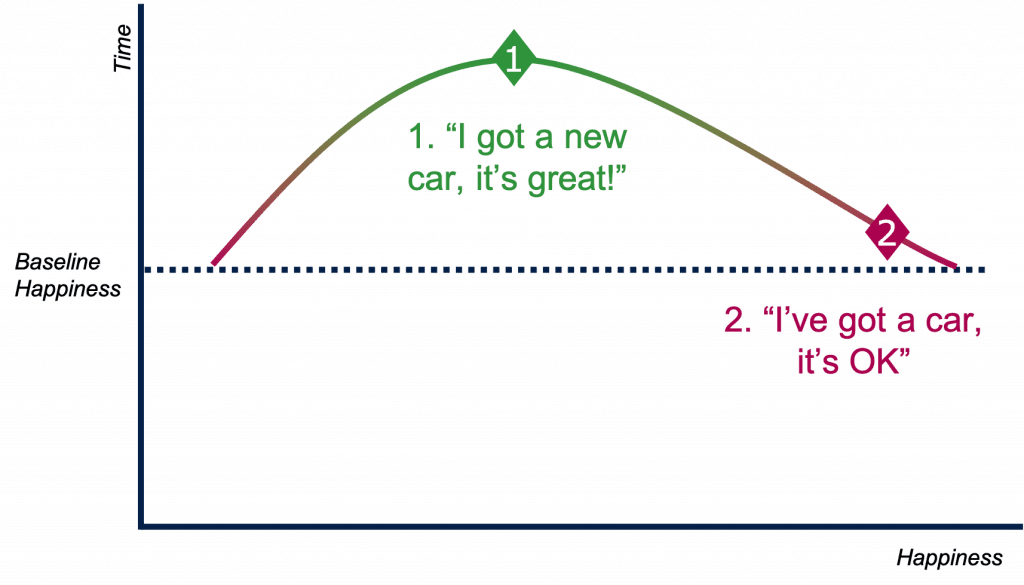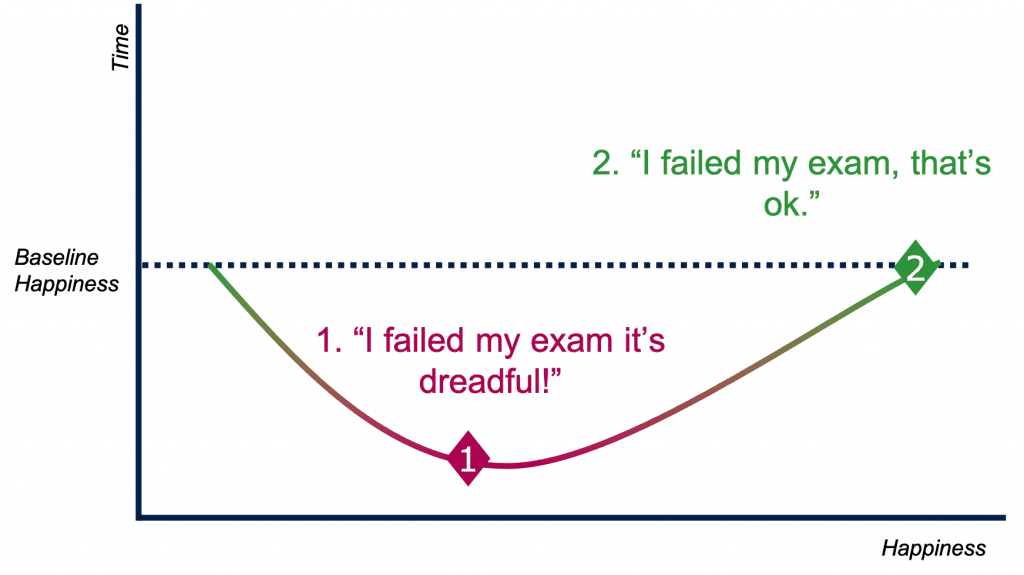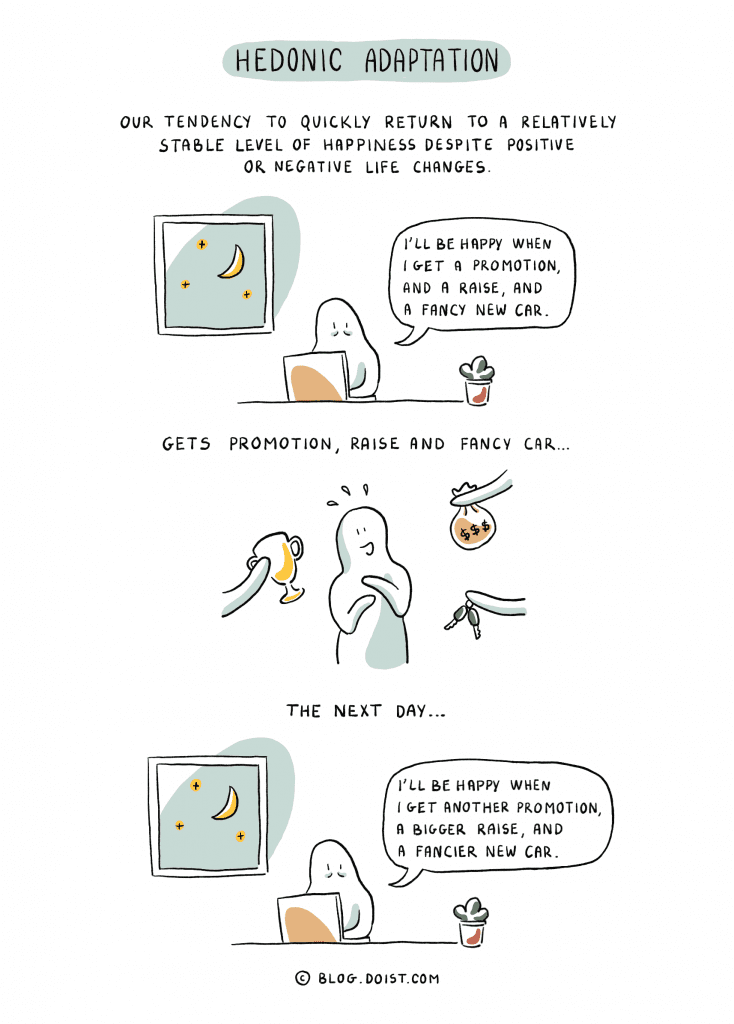🌈 Hedonic Treadmill
Table of Contents
I’m sure you’re like me. It happens time and time again that we pour our hearts into achieving something we think will bring us to that next magical level — where there are rainbows and leprechauns, where we can finally have that sense of achievement and happiness. And we do get that feeling. For the first few hours or days, depending on the size of your achievement. But within a relatively short time, that feeling fades away, and we continue to search for the next level which will bring us rainbows.
There's a scientific explanation for this phenomenon. It's called hedonic adaptation, which results from our brain's ability to quickly adjust to changes in our environment, whether those changes are positive or negative. Essentially, what happens is that we baseline our happiness at whatever point in life, and then an uptick in happiness (like finally getting that thing we wanted) is offset by the return to our baseline level of happiness. So while we may feel thrilled in the moment when we get what we want, that happiness quickly wears off as we become accustomed to the new situation.

A few examples of situations that bring us out of balance are:
- A raise at the job.
- Buying a new house/car/whatever.
- Finishing the first version of the product.
- Death of a close person.
- Job application rejection.
These are all things that deviate from the baseline and result in either euphoric or depressing moments. But eventually, “time heals everything” — we return to our baseline levels.

The Hedonic Treadmill is also essential in the startup world. It works for the customers as well as the employees. For example, once Angry Bird was released, it gained massive success because of its very addictive game design as well as the novelty of such games. Eventually, though, the users’ interest began to wane, and the developers of the game had to release new versions that were slightly different — to keep the attention of their audience. Stuffed toys and other merchandise were developed to maintain some degree of novelty in the brand.
Startup implications
The hedonic adaptation helps explain why a brand must continuously deliver new and different versions of its core message to keep customers engaged over time.
Even if a customer loves a product at first, eventually, that feeling will fade unless the brand can find a way to mix things up. For example, a clothing company might release a new line of clothes each season, a food company might release a unique flavor of ice cream, and a software company might release a v2 or v3 version of their product. By constantly delivering new and improved experiences, brands can keep their customers engaged and prevent them from returning to the base levels.
Software SaaS companies can leverage this phenomenon with small incremental improvements communicated to the client via Newsletter. For example, suppose you’re doing a todo app and feel your customers are returning to their baseline of happiness. In that case, you send them a newsletter issue to motivate them to use the todo app more often to achieve their dreams and tell them to be focused, and you added a Soundscape feature which adds focused music when a task is started.
Organizational Adaptation
The cycle of hedonic adaptation is also crucial to business operations. Initially very excited about their new job, employees become less engaged and start to feel that the grass is greener somewhere else. This is because they habituate to their new work environment, and the tasks become dull over time. While it's normal for employees to undergo this adaptation, it can be harmful to the organization if it leads to high turnover rates.
Another example is when a project gets finished. A team works on a complex and exciting project which eventually gets released with a bang to the customers. There’s a Launch Party, and everyone is ecstatic. But a few weeks later, the team is in maintenance mode, and the bugs pile up, and everything gets dull.
The cycle continues. You, as a business owner, can do a few things to make sure that the employees are less prone to returning to baseline and don’t think that grass is greener somewhere else (because it probably isn’t).
Keep your employees adapting
Give them a chance to excel inside the company. Give them exciting tasks, challenge them to improve themselves, and let them step outside their comfort bubble.
Celebrate and recognize your employees more often. Small wins instead of big promotions. “Weekly Win,” “Monthly Employee” — or message in #general channel on slack to recognize someone’s contributions to the success.
The same goes for negative feedback. It should be done in small chunks to give the person time to improve. Shorter feedback loops are better than yearly reviews — it keeps the employee constantly improving.
If you have frontend developers, offer them to take a glimpse at the backend, it might spark them to pursue a Full Stack job or switch to backend full time. Or vice versa.
Keep track of the most challenging moments you’ve overcome and how you did it — tell the story of how it was before and what problems you used to deal with. Sometimes I remind people of fuck ups we had over the years, and it’s a good thing to remember how far we’ve come.
Offer everyone workations. Remote work is the new standard nowadays. And this helps with the hedonic adaptation — people visit new places, meet new people, and have that feeling of adventure, which adds some happiness.
Work hard, party harder. Sometimes the social connections you make at work become even more valuable than the work itself. This results in less “boring” time at work and more “engaged” time — because you’re building something with friends rather than plain co-workers. Jokes, memes, laughs, and lunch together can make the time at work more valuable.
Happiness comes from within
That being said, you can do all you can as a business owner, but in the end — the job will never replace the inner happiness that a person has. The best thing you can do is spread the message of hedonic adaptation, that in the end, a person should be happy by himself and not rely on external things to make them happy.
Raising satisfaction with work and life will make all of those better, but making all of those better may not boost satisfaction with work or life.

Avoiding Hedonic Treadmill
A good approach to avoiding the hedonic treadmill is to think in “processes” rather than “goals.” If you achieve something, you get used to it. But if you’re on a journey, there’s nothing to adapt to as every day is a journey and brings something new.
If you’re a software engineer, don’t fantasize about finishing a project — savor the creation process. If you’re losing weight, don’t obsess over the number — savor the satisfaction of feeling better.
It’s easy to get caught up in the chase for happiness. From a young age, we’re told that we should pursue our dreams and that we’ll be happy once we achieve our goals. As a result, we often fixate on the outcome of our efforts rather than the act of showing up every day.
The truth is, the outcome won’t make you happier. It’s the act of showing up every day, putting in the work, and giving it your all that will bring fulfillment. So if you’re not enjoying the journey, take a step back and reassess your choices. It might be time to change your perspective and enjoy the moment rather than the goal.
Other Newsletter Issues:
-
Piper
I’ve realized that the real deal for me isn’t just chasing after goals but finding enjoyment in the little things every day. Instead of always looking for the next big achievement, I’ve started focusing on hobbies and activities that genuinely make me happy, like coding for fun or hiking on the weekends. This shift has helped me beat the feeling of constant dissatisfaction and appreciate what I have right now.
-
Jemy
true growth, both personal and professional, lies in understanding this pattern and finding contentment in the process, not just the outcome. It’s not about writing the next big thing, or building products or companies; it’s about building a fulfilling career and life. Enough is enough.
-
Anonymous
As someone managing a team in a fast-paced startup, I see this all the time. We hustle for a project, celebrate for a minute, and then it’s onto the next. It’s a constant cycle.
-
Anonymous
We techies have known this for ages. Chasing the next big thing, be it a gadget, app, or job title, and still feeling meh. It’s like the endless quest for the perfect code – spoiler alert: it doesn’t exist. Maybe we should just chill and enjoy the life, eh?
-
Anonymous
you skrewed up the graph the time and the happieness needs to be switched
-
Felix
I once threw myself into a coding marathon, convinced that launching my app would be the ultimate win. Post-launch, the satisfaction fizzled out faster than a minor bug fix. It struck me then, tech’s promise of perpetual progress is a mirage. Now, disillusioned, I smirk at the relentless updates and upgrades, recognizing the hedonic treadmill tech enthusiasts, myself included, are trapped on.
-
Luna
Chasing the next big achievement or acquisition indeed often leaves us feeling empty shortly after the excitement wears off. I’ve noticed this cycle in my work and personal life, where the initial rush of happiness from success or new purchases fades, pushing me to look for the next big thing. Focusing on the process rather than the outcome has helped me find more satisfaction day-to-day. It’s about enjoying the journey, appreciating the small wins, and understanding that happiness is not a destination but a practice. This shift in perspective has made a significant difference in how I approach my goals and interact with my team, making the everyday grind more fulfilling and productive.
